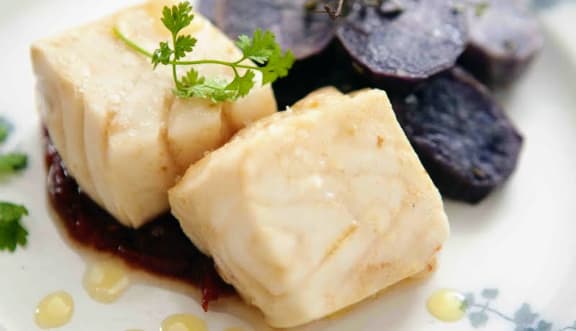To steam wild-caught halibut, we suggest steaming it en papillote — in a packet of parchment paper or aluminum foil. Knowing how to steam halibut is a foolproof approach to making elegant, effortless meals that bring out the best qualities of this exquisitely meaty catch.
Steaming halibut en papillote is one of the most forgiving ways to prepare this lean and mild catch, which is notoriously easy to overcook if you’re not sure what you’re doing. While any fillet of lean fish will become tough when left on the heat for too long, a fillet of halibut can go from done to dry in an instant when you’re using high-heat methods of cooking. The packet of parchment protects halibut from the intense, drying heat of the oven while allowing the fish to retain moisture.
This method also allows you to add liquid seasonings, aromatic components, and tender veggies that will have enough time to steam alongside a delicate protein like fish, allowing you to assemble a full meal in each individual packet.
Steaming Halibut in a Parchment Packet
Preheat your oven to 400 degrees.
Meanwhile, pick a liquid to use as your main steaming medium. Wine, broth, citrus juice or diced tomatoes are all good options. A bit of fat is necessary as well, since halibut is quite lean; if you’re not using a fat-rich liquid like coconut milk to steam your halibut, you’ll definitely want to add oil or butter. For every 6 ounces of halibut you’re making, a good rule of thumb is to use 1-2 tsp of liquid and 2-3 tsp of fat.
Veggies and fruit are fair game, too, as long as they can be steamed to your liking in a relatively short period of time; something like bok choy or diced mangos can be cooked as they are, while you will want to shred or thinly slice ingredients like cabbage or zucchini so that they’ll be tender by the time the halibut is cooked through. Don’t be shy when adding fresh produce to your pouches — add a full serving, if you like — and definitely add some aromatics like herbs or anything in the allium family.
Eyeball how much parchment or foil you think you’ll need to create an envelope or packet that can hold your fillet of halibut with some wiggle room for steam to circulate, laying it out flat and placing a fillet or two in the center. You can use multiple packets to create individual servings, or assemble a larger one to cook a couple together. Note: Parchment is ideal for cooking en papillote, but foil works in a pinch.
Top the halibut with all of your wet and dry ingredients, then seal up the packet as tightly as you can, either by crimping the edges or folding them under so that the weight of the fish keeps the packet closed as it cooks.
Transfer the packet to a baking sheet, then put it in the oven. The baking sheet makes it easier to pull the fish in and out of the oven, and will also capture any spills in case your packets aren’t completely sealed up.
Halibut fillets will need about 10 to 12 minutes to steam, depending on their thickness. The fillets are done cooking when they flake easily with a fork and are opaque throughout, or when they register at 130 degrees with an instant-read thermometer in the thickest part of the fillet. If for some reason the fillets aren’t quite cooked enough when you first open the packets, reseal them as best as you can and allow the fish to steam for another minute or two.
Serve the packets immediately, opening them carefully at the table, or transfer to individual dishes if you don’t like the look of your packets. Take care when diving in, as they’ll release a hot puff of steam upon opening.
Steamed Halibut Inspiration
This recipe for halibut en papillote from Food52 features a varied mix of farmer’s market veggies to add color and flavor to the meal. A Mediterranean medley of olive oil, lemon juice, and kalamatas is just bold enough to define the dish without overpowering the delicate flavor of the fish.
The clean, herbaceous flavors of cilantro and ginger bring this Martha Stewart recipe for steamed halibut to life, while cabbage and carrots round out the meal with some fresh texture.
Suvir Saran’s recipe for halibut layers on lots of flavor by steaming the fish with a spicy, creamy mint-coconut chutney, perfect with a side of basmati rice.
And pictured above is a whiskey-steamed Alaska halibut, from our friends at ASMI (Alaska Seafood Marketing Institute).






